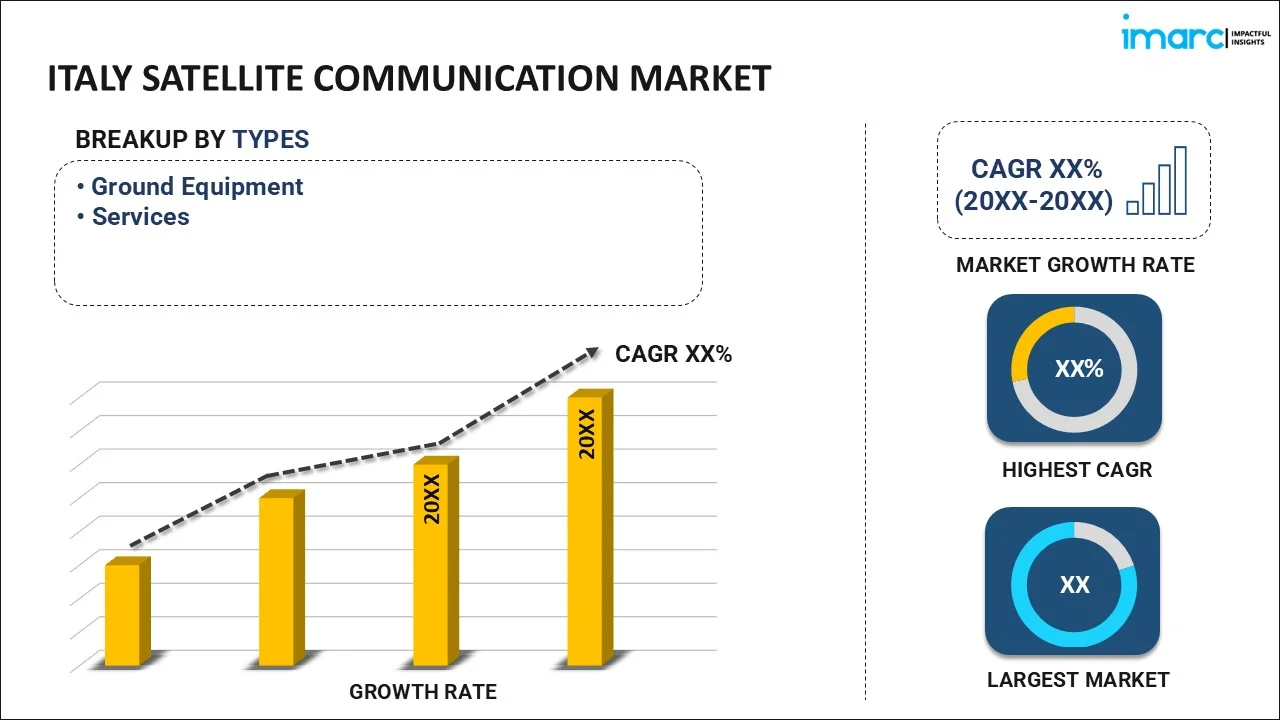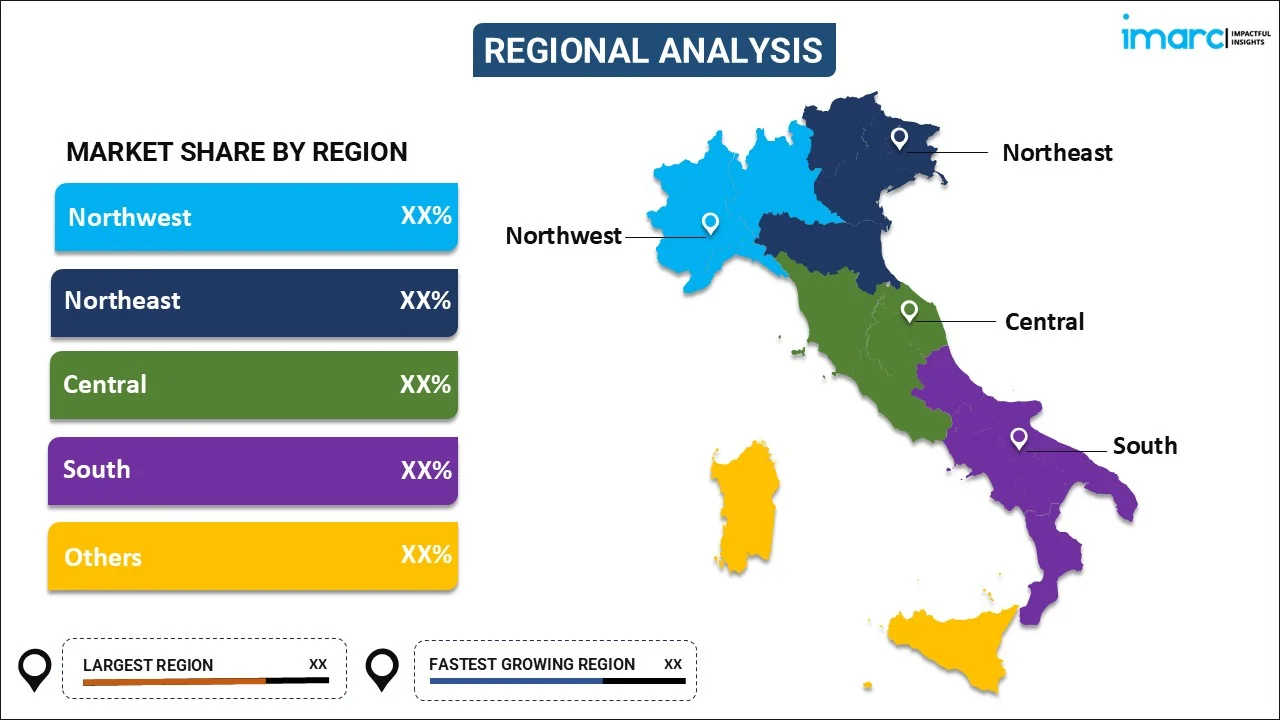
Italy Satellite Communication Market Size, Share, Trends and Forecast by Type, Platform, End Use Vertical, and Region, 2025-2033
Italy Satellite Communication Market Overview:
The Italy satellite communication market size reached USD 3.04 Billion in 2024. Looking forward, IMARC Group expects the market to reach USD 7.15 Billion by 2033, exhibiting a growth rate (CAGR) of 9.22% during 2025-2033. The Italy satellite communication market is driven by increasing government investments in secure telecommunications infrastructure, strategic collaborations with global players like SpaceX and Skyloom, and advancements in optical and laser-based satellite communication technologies, enhancing data transmission, connectivity, and national security while positioning Italy as a key player in the European space sector.
|
Report Attribute
|
Key Statistics
|
|---|---|
|
Base Year
|
2024
|
|
Forecast Years
|
2025-2033
|
|
Historical Years
|
2019-2024
|
| Market Size in 2024 | USD 3.04 Billion |
| Market Forecast in 2033 | USD 7.15 Billion |
| Market Growth Rate (2025-2033) | 9.22% |
Italy Satellite Communication Market Trends:
Government Investment in Satellite Communication
The government of Italy has shown a high level of dedication to improving its satellite communication capacities through significant monetary investments. In March 2023, Italy's government authorized a decree for the implementation of EU Directive 1937/2019, with an emphasis on the protection of critical infrastructure, including satellite communications. This legislative action highlights the government's acknowledgment of satellite communication as an essential aspect of national security and technological progress. Further emphasizing this commitment, in June 2022, the Italian Ministry of Defense awarded a contract for the development of the SICRAL 3 satellite communications system. This project involves multiple implementation phases, with the SICRAL 3A satellite scheduled for launch by 2026, followed by SICRAL 3B. The initiative aims to enhance Italy's military communication capabilities, reflecting a strategic investment in defense infrastructure. Along with local initiatives, Italy is also engaging proactively in global partnerships to support its satellite communications infrastructure. Significantly, the nation is involved in the European Union's IRIS² project, a €10.6 billion secure satellite constellation due to be fully operational by the end of 2030. The project will offer encrypted communications for EU member states, with Italy winning one of the three main ground stations in the Abruzzo region. Such engagement not only heightens Italy's technological strength but also places it in a central role in Europe's collective security arena.
Infrastructure Development in Satellite Communication
Infrastructure development is at the core of Italy's policy to develop its satellite communication. One of the pillars of this policy is cooperation with private players to upgrade and increase the infrastructure. In January 2025, Italy negotiated with SpaceX to use its Starlink satellite system for secure government communications. The planned €1.5 billion deal seeks to offer encrypted services for state government activities, the military, and emergency services within five years. The collaboration will help substantially develop Italy's communications infrastructure with fast, dependable connections nationwide. Parallel to this, Italy is countering the obstacles in broadband deployment by coming up with creative solutions. Up to the end of 2023, Fiber to the Home (FTTH) reached only 3.4 million homes, covering 54% of the target, while only 18,616 public administration buildings and industrial estates had been connected (62%). To fill this chasm, Italy intends to launch tests for the satellite services offered by Starlink from January 2025 to determine how best to accelerate rollouts of high-speed internet across the country, especially to the most far-flung areas. This program signifies a real-world approach to network development using modern satellite capabilities in conjunction with land-based systems to speed the realization of a country-wide goal of coverage.
Italy Satellite Communication Market Segmentation:
IMARC Group provides an analysis of the key trends in each segment of the market, along with forecasts at the region/country level for 2025-2033. Our report has categorized the market based on type, platform, and end use vertical.
Type Insights:

- Ground Equipment
- Services
The report has provided a detailed breakup and analysis of the market based on the type. This includes ground equipment and services.
Platform Insights:
- Portable
- Land
- Maritime
- Airborne
A detailed breakup and analysis of the market based on the platform have also been provided in the report. This includes portable, land, maritime, and airborne.
End Use Vertical Insights:
- Maritime
- Defense and Government
- Enterprises
- Media and Entertainment
- Others
A detailed breakup and analysis of the market based on the end use vertical have also been provided in the report. This includes maritime, defense and government, enterprises, media and entertainment, and others.
Regional Insights:

- Northwest
- Northeast
- Central
- South
- Others
The report has also provided a comprehensive analysis of all the major regional markets, which include Northwest, Northeast, Central, South, and others.
Competitive Landscape:
The market research report has also provided a comprehensive analysis of the competitive landscape. Competitive analysis such as market structure, key player positioning, top winning strategies, competitive dashboard, and company evaluation quadrant has been covered in the report. Also, detailed profiles of all major companies have been provided.
Italy Satellite Communication Market News:
- January 2025: Italy negotiated with SpaceX to use Starlink for secure government communications, potentially worth €1.5 billion over five years. Italy also considered a domestic satellite system to lower dependency on foreign providers. These developments propelled Italy's satellite communication market by building out secure infrastructure and supporting local satellite capability.
- October 2024: Skyloom, a U.S.-based optical communications company, formed a joint venture with Italian manufacturer Officina Stellare to establish Skyloom Europe, aiming to produce optical communications terminals in northern Italy. This collaboration will enhance Italy's satellite communication market by introducing advanced laser-based technologies, increasing data transmission capabilities, and positioning Italy as a key player in the European secure satellite communications sector, projected to reach a market value of approximately €12 billion by 2031.
Italy Satellite Communication Market Report Coverage:
| Report Features | Details |
|---|---|
| Base Year of the Analysis | 2024 |
| Historical Period | 2019-2024 |
| Forecast Period | 2025-2033 |
| Units | Billion USD |
| Scope of the Report |
Exploration of Historical Trends and Market Outlook, Industry Catalysts and Challenges, Segment-Wise Historical and Future Market Assessment:
|
| Types Covered | End Use Vertical |
| Platforms Covered | Portable, Land, Maritime, Airborne |
| End Use Verticals Covered | Maritime, Defense and Government, Enterprises, Media and Entertainment, Others |
| Regions Covered | Northwest, Northeast, Central, South, Others |
| Customization Scope | 10% Free Customization |
| Post-Sale Analyst Support | 10-12 Weeks |
| Delivery Format | PDF and Excel through Email (We can also provide the editable version of the report in PPT/Word format on special request) |
Key Questions Answered in This Report:
- How has the Italy satellite communication market performed so far and how will it perform in the coming years?
- What is the breakup of the Italy satellite communication market on the basis of type?
- What is the breakup of the Italy satellite communication market on the basis of platform?
- What is the breakup of the Italy satellite communication market on the basis of end use vertical?
- What are the various stages in the value chain of the Italy satellite communication market?
- What are the key driving factors and challenges in the Italy satellite communication?
- What is the structure of the Italy satellite communication market and who are the key players?
- What is the degree of competition in the Italy satellite communication market?
Key Benefits for Stakeholders:
- IMARC’s industry report offers a comprehensive quantitative analysis of various market segments, historical and current market trends, market forecasts, and dynamics of the Italy satellite communication market from 2019-2033.
- The research report provides the latest information on the market drivers, challenges, and opportunities in the Italy satellite communication market.
- Porter's five forces analysis assist stakeholders in assessing the impact of new entrants, competitive rivalry, supplier power, buyer power, and the threat of substitution. It helps stakeholders to analyze the level of competition within the Italy satellite communication industry and its attractiveness.
- Competitive landscape allows stakeholders to understand their competitive environment and provides an insight into the current positions of key players in the market.
Need more help?
- Speak to our experienced analysts for insights on the current market scenarios.
- Include additional segments and countries to customize the report as per your requirement.
- Gain an unparalleled competitive advantage in your domain by understanding how to utilize the report and positively impacting your operations and revenue.
- For further assistance, please connect with our analysts.
 Request Customization
Request Customization
 Speak to an Analyst
Speak to an Analyst
 Request Brochure
Request Brochure
 Inquire Before Buying
Inquire Before Buying




.webp)




.webp)












